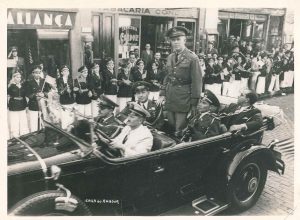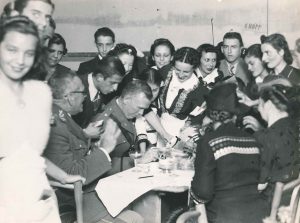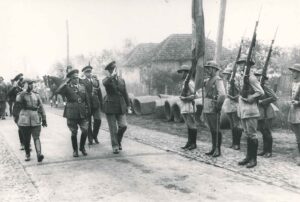 Only two weeks after the public announcement that President Franklin D. Roosevelt had appointed General George C. Marshall as the next chief of staff of the U.S. Army, Marshall found himself aboard the cruiser U.S.S. Nashville en route to his first visit to a foreign country. His destination was not Great Britain, France, the Soviet Union, or China. Marshall was traveling to Brazil and would arrive in Rio de Janeiro on May 25, 1939. Civilian and military leaders in the United States had expressed concerns about the uncertain political climate in Brazil for some time and saw Brazil as vital to the defense of the Western Hemisphere and stability in Latin America. Marshall’s visit, at the invitation of Brazilian Foreign Minister Oswaldo Aranha, was expected to strengthen the alliance between the United States and Brazil
Only two weeks after the public announcement that President Franklin D. Roosevelt had appointed General George C. Marshall as the next chief of staff of the U.S. Army, Marshall found himself aboard the cruiser U.S.S. Nashville en route to his first visit to a foreign country. His destination was not Great Britain, France, the Soviet Union, or China. Marshall was traveling to Brazil and would arrive in Rio de Janeiro on May 25, 1939. Civilian and military leaders in the United States had expressed concerns about the uncertain political climate in Brazil for some time and saw Brazil as vital to the defense of the Western Hemisphere and stability in Latin America. Marshall’s visit, at the invitation of Brazilian Foreign Minister Oswaldo Aranha, was expected to strengthen the alliance between the United States and Brazil
In a report to Chief of Staff Malin Craig dated May 26th Marshall described how he rode “in the President’s open car” and how “the people thronged in the rear of the troops and applauded rather generously.” Marshall described the numerous receptions, parades, luncheons, dinners held in his honor and noted that the Brazilian government was “doing this in great style.”
 Even though Marshall received a warm welcome everywhere he visited, the days were long and demanding. He wrote to General Craig on June 1st that he had “been traveling since last Wednesday, six days ago—all by air, with a very strenuous program and a devilish number of speeches a day—and under any and every condition.” At each place Marshall visited he was greeted by local government officials, encountered thousands of people along the route of his escort, and attended dinners or banquets with local dignitaries followed by a ball or a dance. Marshall also spent a considerable amount of time inspecting military installations and military-related industries including “a frontier regiment at its barracks” in Porto Alegre.
Even though Marshall received a warm welcome everywhere he visited, the days were long and demanding. He wrote to General Craig on June 1st that he had “been traveling since last Wednesday, six days ago—all by air, with a very strenuous program and a devilish number of speeches a day—and under any and every condition.” At each place Marshall visited he was greeted by local government officials, encountered thousands of people along the route of his escort, and attended dinners or banquets with local dignitaries followed by a ball or a dance. Marshall also spent a considerable amount of time inspecting military installations and military-related industries including “a frontier regiment at its barracks” in Porto Alegre.
Adding to the difficulty of Marshall’s visit was the direct impact that it would have on future U.S-Brazil relations. Marshall’s first report to General Craig noted “The present mission seems to be working out OK, from all I hear.” Marshall then wrote about his attendance at a palace reception for Countess Ciano, Benito Mussolini’s daughter. The countess arrived in Brazil about the same time as General Marshall and according to some Brazilians her visit was in response to Marshall’s visit as the U.S. and Italy competed to secure Brazil as an ally.
Marshall reported to General Craig that Foreign Minister Aranha provided invaluable help during Marshall’s visit. He wrote that Aranha “states his desires, solicits my assistance in influencing Brazilian Generals, advises me, explains the things he would like Monteiro to see in the U.S.…” After he spent more time touring the country Marshall observed, “The reception given us has been remarkable, with a steadily increasing enthusiasm.” Marshall likely played a part in generating this additional enthusiasm through his decisions to send candy to 200 boys from an agricultural orphanage who participated in a parade in Curitiba and to get out of his car and walk through the streets to greet the school children who welcomed him in Belo Horizante.
 Marshall departed Rio de Janiero for the United States on June 7th and arrived in Annapolis, Maryland on June 20th. His successful visit to Brazil and the equally successful visit of General Pedro Aurelio de Goes Monteiro, chief of staff of the Brazilian Army, to the United States laid the foundation for a strong partnership that continued when both countries eventually became involved in World War II.
Marshall departed Rio de Janiero for the United States on June 7th and arrived in Annapolis, Maryland on June 20th. His successful visit to Brazil and the equally successful visit of General Pedro Aurelio de Goes Monteiro, chief of staff of the Brazilian Army, to the United States laid the foundation for a strong partnership that continued when both countries eventually became involved in World War II.
Included in George C. Marshall’s Papers are two photo albums documenting General Marshall’s travels in Brazil, a selection of which are featured in this blog post. To schedule a visit to view these photo albums or other records in the archives relating to Marshall’s visit to Brazil please contact the research library staff.
